
MARS FORESTS MIXING
Report #091
August 28, 2005
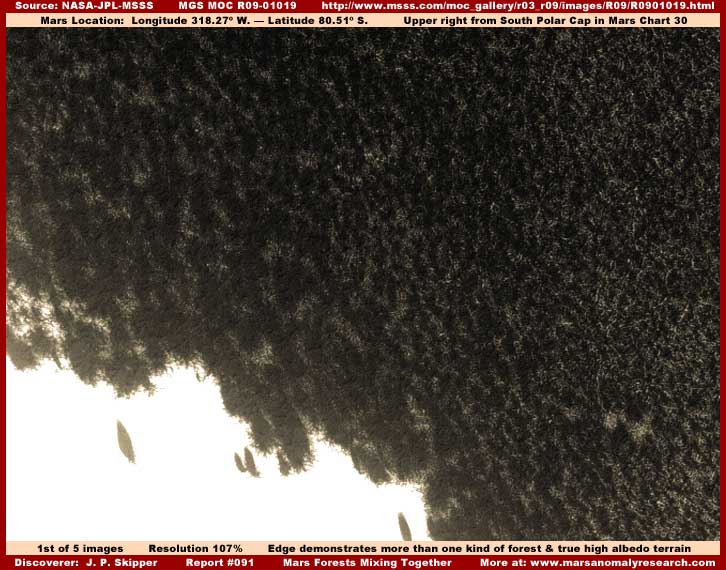
The recent ESA official acknowledgment of surface water ice in at least one lone site on Mars and NASA appearing indirectly to go along with this revelation has motivated me to release some more of my own biological life discoveries as a supplement to my last Report #090 on the same subject. After all, the presence of surface water, even in the form of a solid like water ice, has implications for the potential presence of biological life (like forests) capitalizing on this very real life enabling resource.
So here we go again with more forest evidence that is suppose to be so impossible on Mars according to the past and current official positions espoused by the majority of the science and academic communities. I'm devoting this report mainly to forest evidence from a single R09-01019 narrow-angle science data strip but I'm also including some very suggestive liquid surface water evidence from its companion R09-01020 wide-angle context strip. The M09-01019 based evidence here demonstrates more than one forest type mixing and merging together with each other. This demonstrates not only how the forest evidence differentiates from the true high albedo (reflectivity) terrain in this area but the fact that large areas of the forest evidence engulfs and covers over the terrain confirming active dynamic biological life on the advance rather than inanimate geology.
Again I'm compelled to make the observation, just as I did in the previous Report #090, that it is incredibly sad that the mainstream science and academic communities and even the just as well educated science media apparently cannot see and recognize this evidence for what it is or at the very least come out in support of its truth once they are aware of it. That appears to be the case in spite of the fact that evidence like this is so very plain and in one's face in the official science data and not always obscured by the secrecy agenda image tampering. This forest evidence may not be entirely familiar to the Earth human eye but that just isn't an excuse that will fly when it comes to recognition of what is so obviously biological life of some kind on this distant world.
With that frustration vented for the time being, the above first image is of the perimeter edge of a dense thick forest located at the very bottom of the image strip and it appears to be made up of more than one forest form of life. The above first image encompasses the evidence from one side of the strip to the other. The darker area is of course the forest life evidence and the bright light reflective area in the lower left corner of the above image is the true very high albedo Mars terrain geology.
You should be aware that the already extra bright reflective visual quality of the terrain in the official image has been made a little more so here by my attempts to bring out as much detail as possible of the darker life evidence. Preserving the terrain visual detail isn't as important here in the context of this report as it was in my previous Report #090 titled More Mars Forests & Lakes." However, it is still very important that you at least recognize the true overly light reflective areas for the terrain geology that it is. Why? Well because this recognition provides the background upon which this biological life sits and covers over as it actively spreads across a geological region. It is this active growth, spreading, and engulfing process that demonstrates that this darker evidence isn't some strange form of inanimate darkly colored rough geology (rock, chemical, soil, etc.) but dense dynamic growing life spreading over and engulfing the true natural highly light reflective geology.
What is not necessarily very readily apparent in the above first image is that the type of life evidence at the leading edge of the darker mass forest where it borders on the high albedo terrain does not appear to be the same type of forest life as that further back in the dense interior of the overall dark mass area. There seems to be some close similarities between this leading edge life evidence and that in my previous Report #090. Note the same flat dull very light absorbing color and the patches with their branching runners by which this life no doubt spreads. More images below will demonstrate its similar smoother surface texture and apparent lower growing height characteristics. Yes, very similar, if not the same.
On the other hand, note that the patch evidence in Report #090 is more rounded in circumference while the similar patch evidence here in this strip is more elongated in shape. This could be due to differences in the terrain causing this visual look and it may well be the same type of evidence. On the other hand, other images below show this evidence to be a little more rough textured and not quite as smooth on its surface as that in Report #090. In this evidence the branching runners appear to be more pronounced in shape relief under the carpeting upper surface cover causing that rougher look. I suspect this life evidence to be perhaps in the same family as that in Report #090 but maybe a different branch subtly different in being a little more heavily constructed.
Now note that further back in the interior of the dark mass area away from the leading edge in the first image, the life evidence changes in its appearance and texture. Note that, although still dark and overall light absorbing, the overall light reflectivity factor of this area increases in this type of forest evidence. However, the source of this increased reflectivity appears to be coming from many individual branching runner component parts rather than from the overall mass upper surfaces. This implies that the underlying more light reflective branching runners are harder exposed surfaces. Likewise, the softer more light absorbing and fuzzy center darker surfaces seen in this image area within the center area of the branching runners appears to be much finer textured.
The question then becomes are we looking at possibly multiple different forest life form species mingling here or are we looking at one type of life that changes its basic structure as it increasingly matures deeper back in the older more established areas. You can bet that it's not going to be easy to make such distinctions based on just this type of distant visual evidence.
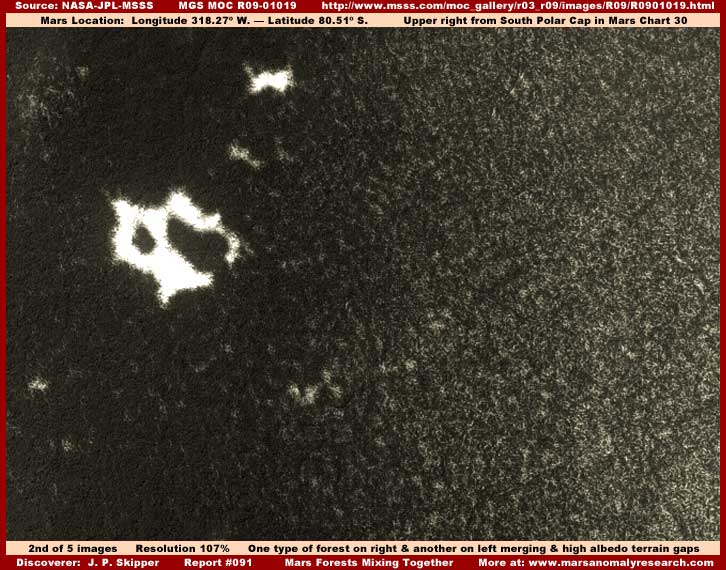
In the above second image, although here again this may not be readily apparent, this is a half and half transition image. The evidence in the right half is the much more light reflective life and the evidence in the left half is darker not so much because of differences in lighting or terrain level casting shadow but because the life evidence there is darker, much finer textured and absorbs light much more. There could be darker color differences impacting this appearance factor to but we can't adequately determine that in this type of black and white imaging as released to us. As you cans see, the transition between right and left halves is not sharp but is very gradual because of the intermingling and merging of the two different types.
Note in the left half of this second image the contrasting patches of exposed bright highly light reflective terrain geology not yet engulfed and covered over. Just like in the first image, this very high light reflectivity terrain geology and lack of shadows thrown by much of anything around the perimeter of this patch tells us that the sun angle is pretty much high overhead just as the camera angle is. Even so, you should also be aware that this whole area is very dark in the original strip view and had to be substantially lightened by me to reveal this detail. This confirms to us that the darker area on the left is a function of the light absorbing qualities of the life form itself revealing this pronounced difference between it and the more light reflective life on the right.
The very light color patches also tells us how strongly light reflective the true natural terrain really is in this area. That in turn tells us that this dark mass evidence is something that covers and obscures the true natural bright light reflective terrain geology from our view and that the dark evidence is not to be confused with being inanimate natural geological terrain. Of course the many branching runners evidence seen extending out into the light reflective natural terrain areas and contrasting so sharply against it also reinforces the growing, spreading dynamic and alive concept associated with this dark area evidence.
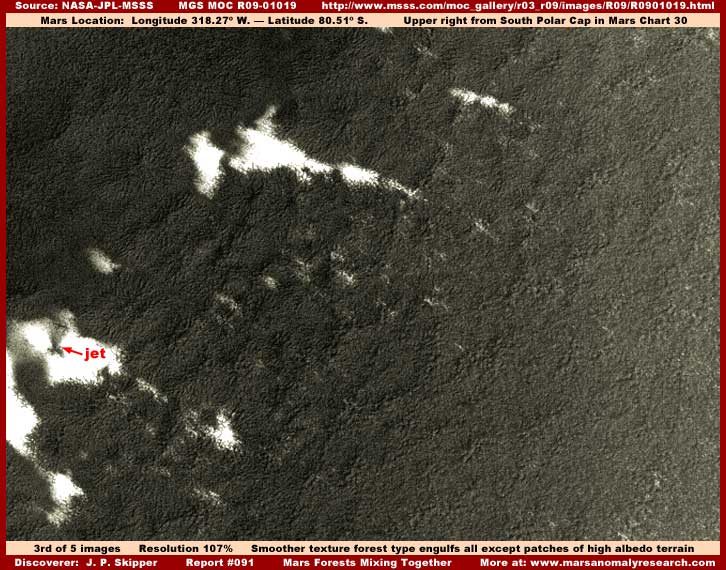
Just in case one may tend to lean in favor of the speculation that all this dark forest life evidence is the same life, perhaps just seen in different stages of development, the above third image from the same strip tends to favor a different interpretation. Very much like the life evidence in Report #090, this life evidence located in the upper area of this strip (very dark in the original science data strip and lightened by me here to show more detail) appears to all be the same type and note that it is clearly mature and/or well established enough to have completely engulfed all of the terrain to the right of the light color terrain patches.
Yet, except for the bright reflective exposed terrain patches in the left half demonstrating strong and direct sunlight, note that this evidence area absorbs light and has none of the more light reflective qualities of the other forest life evidence also in evidence in this strip and reported on here. Note also that it appears to be relatively low growing similar to the Report #090 evidence and appears likely to spread via extending branching runners.
However, note that it is also different in that the surface texture, below the light absorbing covering upper layer, appears to be rougher revealing the likely presence of harder component underlying branching runners. The few minor points of light reflectivity seen in the lower right corner dark mass area are actually the beginning edges of the more light reflective type of life evidence, the most prolific of which can be seen in the next image below.
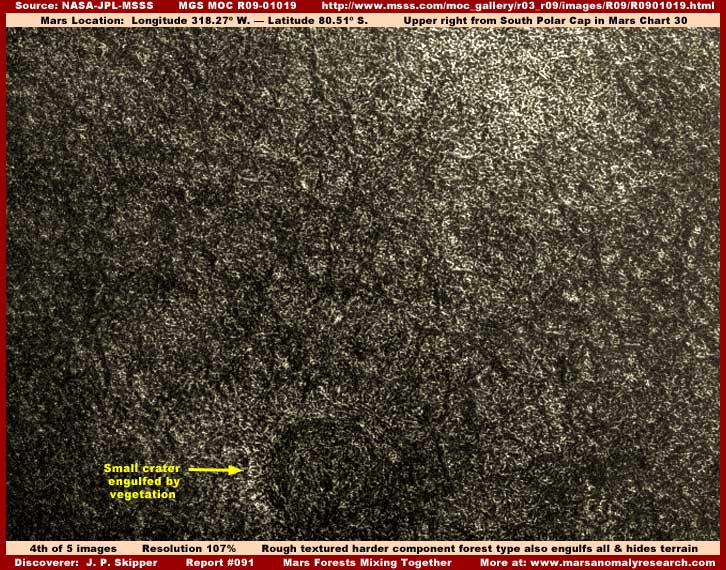
As you can see in the above fourth image, the more light reflective life evidence rough surface texture is considerably different than the evidence in the third image and possibly even different than the light reflective evidence in the first image here. I might also point out that where you see this type of life evidence well established in this science data strip as in the above fourth image, you do not see any patches of open high albedo natural terrain and the same isn't true of the only one type of life evidence in the third image. Note the faintly seen small crater or pit pointed out by my yellow color labeling that has been completely engulfed with even its basic outline almost hidden from view by this rougher texture forest life.
Now take special close note of the details of the more light reflective area in the upper right of this fourth image demonstrating a great tangle of more exposed hard surface branching runners. Is this an area of doing poorly with dying more exposed branches or what happens when the tangle gets too thick and pushes upward exposing the runners more? It appears that we are looking at a much harder bodied (wood?) vegetation life in this fourth image than that in the third image. The unusually larger file size of this fourth image in comparison to the third image evidence counting many more individual hard objects in this fourth image tends to support such an observational assessment.
In the relative sense, I suspect the life evidence in the above fourth image is overall more competitive and aggressive as to the typical strong arm tactics of wild unchecked (by our definition) plant life prying out a little sunlight space for itself among its competition and may also represent a number of different mixed competing plant life form species as opposed to same type life form in the third image. What visual evidence we can see here here tends to support such a diversity interpretation but of course doesn't guarantee it.
On the other hand, what we can be pretty certain about is that, at least in these extensive dark areas, the simple fact is that we are looking at a lot of competing and flourishing biological life of some kind at the very minimum here as opposed to inanimate geology and it's undeniably on the distant world of Mars. The science and academic communities have got to start waking up to this obvious basic reality and this necessitates the need to revisit the possibility that Mars very well may be a much more favorable environment than officially reported and the majority of us have so far believed!
Obliviously, while some of this life may be different than our Earth experience, some of it may very well be vegetation plant life similar to what we are familiar with here on Earth. Further, the extensive areas of this similar plant life evidence are likely serving as a serious oxygen pump into the Mars atmosphere. That in turn has all kinds of questions and implications for the correctness of a lot of the basic official foundation science data that so heavily influences science computer modeling and conclusions as well as of course the concept of the survivability of life. We're talking about basic foundation data like the officially reported atmospheric CO2 levels, hard freezing temperatures, and dry as dust conditions.
By the way, some viewers may question why there are really no closer views here in this report of this life evidence? The reason is because of the poor resolution in this official image strip. It degrades very quickly and does not allow much closer imaging without too many visual problems. Of course I suspect this is by intent to prevent the needed closer examination.
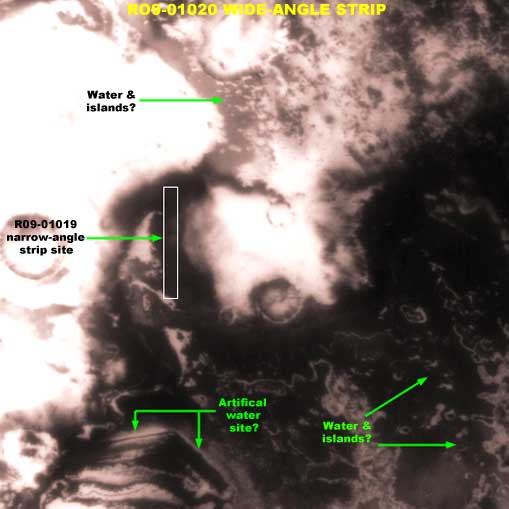
The above fifth image is the narrow-angle R09-01019's companion R09-01020 wide-angle context image. Note the location of the R09-01019 strip within this context image. This evidence isn't by any stretch definitive or conclusive because of the wide-angle limited resolution and distant view but I thought you might at least be interested in seeing how so much of this companion image's content has what appears to possibly be surface water sites in it.
In fact, one of them on the lower left with its precise measured and unusual long narrow dimensions appears to be too straight and uniform in an inverted "V" shape strongly suggesting an artificially created site. Further, note on its left angled half what appears to be bright terrain bank reflections across the waterline boundary and out in the liquid surface. That's pretty suggestive evidence.
DOCUMENTATION
http://www.msss.com/moc_gallery/r03_r09/images/R09/R0901019.html: This link will take you to both of the official R09-01019 and R09-01020 science data imaging strips from which the evidence in this report is drawn. Note that, except for a small light terrain patch at the very bottom, 99% of the rest of the R09-01019 narrow-angle strip is very dark and you will not see the kind of detail that you see in my report images that have been lightened and clarified. It is dark primarily because the life evidence is so prevalent, dark and light absorbing.
, Investigator
![]()